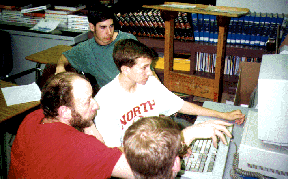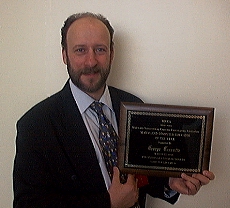The Graduate Manifesto of George Cassutto
I Stand Connected
 After I met my then fiancée, Teresa, in 1988, I was introduced to the world
of computers by my then father-in-law, who brought me his company's old cast
offs. First came the text-only green-screen Decision-Mate V (AT & T's
attempt at an early word processor). The came the color 8086 processor,
followed by the 286, 386, and 486 processor chips. Each machine did a little
more in terms of speed and graphics. By 1994, I took the plunge and taught
myself Windows 3.1, bravely weaning myself from the security of the DOS prompt.
In March of 1994, I had been experimenting with BBS (bulletin-board messaging
systems) and had joined a new on-line service called America On-line (DOS
version 1.5). Modems at that time operated at a speed of 14.4 kilobytes per
second, which seemed very fast compared to the 300 baud modems of earlier
generations. One by one, I began to gather stand-alone PCs and placing them in my
classroom so that students could engage in simple word processing. I had placed
some student essays on a few BBS discussion boards, allowing people from all
over the world to review and respond student work. Students in AP History found
the process very useful when they prepared for their DBQ (document-based
questions).
After I met my then fiancée, Teresa, in 1988, I was introduced to the world
of computers by my then father-in-law, who brought me his company's old cast
offs. First came the text-only green-screen Decision-Mate V (AT & T's
attempt at an early word processor). The came the color 8086 processor,
followed by the 286, 386, and 486 processor chips. Each machine did a little
more in terms of speed and graphics. By 1994, I took the plunge and taught
myself Windows 3.1, bravely weaning myself from the security of the DOS prompt.
In March of 1994, I had been experimenting with BBS (bulletin-board messaging
systems) and had joined a new on-line service called America On-line (DOS
version 1.5). Modems at that time operated at a speed of 14.4 kilobytes per
second, which seemed very fast compared to the 300 baud modems of earlier
generations. One by one, I began to gather stand-alone PCs and placing them in my
classroom so that students could engage in simple word processing. I had placed
some student essays on a few BBS discussion boards, allowing people from all
over the world to review and respond student work. Students in AP History found
the process very useful when they prepared for their DBQ (document-based
questions).
| At about the same time, my best friend Steve, who had graduated from
University of Maryland with a B.A. in Computer Science in 1978, showed me how to
code pages for the newest medium on the Internet, a graphical user interface (or
GUI, pronounced "Gooey"), known as the World Wide Web. He also showed
me the basics in graphics editing, and we married the two skills up in his
basement as we converted a set of text-only AP student essays into a nascent
website. |

|
|
Maryland's Computer Educator of the Year |
|
The North Hagerstown High
School website was born. I was able to get a local internet service provider to
donate one account to the school, which is where we gained the web space upon
which to mount the first few pages. For the remainder of my tenure at North Hagerstown
High, I would strive to bring computing, networking, and the Internet into my
classroom and every classroom in the school. The word about the website spread
quickly, and during the last half of the 1990s, I was speaking, training, and
writing web pages for schools, businesses, and churches all over Maryland. I
even published a small pamphlet-like book called Internet Pocket Guide for
Teachers. In 1998, I was chosen as Maryland's Computer Educator of the Year by a
group of fellow teachers. |
| The Internet bubble burst in 2000, so there were fewer opportunities to share
the power of the Internet with other establishments inside and outside of
education. Moreover, I had a growing family, and the low pay scale of Washington
County, Maryland was not sufficient upon which to buy a single-family home. So, on the tip
of a friend, I looked into transferring to one of the fastest growing counties
and school systems in the region, that of Loudoun County, Virginia. In 2000, I
made the move to Loudoun, leaving high school for a middle school slot, leaving
PCs for Macs, and commuting about an hour from Frederick. I had to move all of
my projects and pages to my own web space. I wanted a place on the Web where
student publishing was central to the site, but I also wanted a place where
teachers could get lesson plans and ideas for projects free of charge. |
I wanted a place on the Web where
student publishing was central to the site, but I also wanted a place where
teachers could get lesson plans and ideas for projects free of charge.
|
So I named the website Cyberlearning-world.com. The website's central focus was
that the Web could be a place where students and teachers could learn and teach
via computer and Internet technology. Many months of online time were devoted to building the
site from existing student projects and transferring data to the new web space
so that it would work. I was not aware that in my attempt to survive in a technologically
accelerated world, I was losing the connection that had seen me through all those
previous changes, that of my wife and family. In October of 2001, I heard the
words "I want a divorce."
 Change
is the only Constant
Change
is the only Constant
 After I met my then fiancée, Teresa, in 1988, I was introduced to the world
of computers by my then father-in-law, who brought me his company's old cast
offs. First came the text-only green-screen Decision-Mate V (AT & T's
attempt at an early word processor). The came the color 8086 processor,
followed by the 286, 386, and 486 processor chips. Each machine did a little
more in terms of speed and graphics. By 1994, I took the plunge and taught
myself Windows 3.1, bravely weaning myself from the security of the DOS prompt.
In March of 1994, I had been experimenting with BBS (bulletin-board messaging
systems) and had joined a new on-line service called America On-line (DOS
version 1.5). Modems at that time operated at a speed of 14.4 kilobytes per
second, which seemed very fast compared to the 300 baud modems of earlier
generations. One by one, I began to gather stand-alone PCs and placing them in my
classroom so that students could engage in simple word processing. I had placed
some student essays on a few BBS discussion boards, allowing people from all
over the world to review and respond student work. Students in AP History found
the process very useful when they prepared for their DBQ (document-based
questions).
After I met my then fiancée, Teresa, in 1988, I was introduced to the world
of computers by my then father-in-law, who brought me his company's old cast
offs. First came the text-only green-screen Decision-Mate V (AT & T's
attempt at an early word processor). The came the color 8086 processor,
followed by the 286, 386, and 486 processor chips. Each machine did a little
more in terms of speed and graphics. By 1994, I took the plunge and taught
myself Windows 3.1, bravely weaning myself from the security of the DOS prompt.
In March of 1994, I had been experimenting with BBS (bulletin-board messaging
systems) and had joined a new on-line service called America On-line (DOS
version 1.5). Modems at that time operated at a speed of 14.4 kilobytes per
second, which seemed very fast compared to the 300 baud modems of earlier
generations. One by one, I began to gather stand-alone PCs and placing them in my
classroom so that students could engage in simple word processing. I had placed
some student essays on a few BBS discussion boards, allowing people from all
over the world to review and respond student work. Students in AP History found
the process very useful when they prepared for their DBQ (document-based
questions).